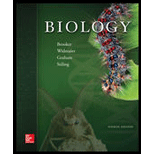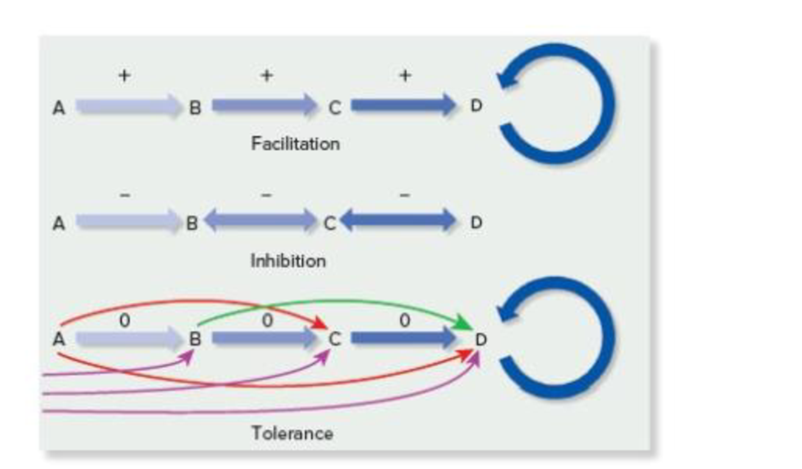
Concept explainers
Inhibition implies that competition exists between species, with early-arriving species tending to outcompete later arrivals, at least for a while. Does competition or mutualism feature more prominently in facilitation?

Figure 58.8 Three models of succession. A, B, C, and D represent four stages, with D representing the climax community. An arrow means “is replaced by,” + stands for “facilitation,” − stands for “inhibition,” and 0 indicates no effect. The facilitation model is the classic model of succession. In the inhibition model, early-arriving species outcompete later-arriving species. The tolerance model depends on which species gets there first. The colored arrows show that succession may bypass some stages in the tolerance model.
Want to see the full answer?
Check out a sample textbook solution
Chapter 58 Solutions
Biology
- Competition between species on the same trophic tier leads to four potential outcomes, 3 are deterministic (zero sum games where one species goes extinct and the other maximizes their growth to balance at the carrying capacity) and one where both competitors survive, but neither does well. A) This dynamic suggests that extirpation (local extinction) of populations is a far more likely outcome than co-existence. How does this affect management policies aimed at increasing biodiversity and proliferation of inter and intra population and interspecies variation. B) Endangered species are defined by low growth rates (r) and low K (reflecting high demand for resources). What are the implications of both these factors on the outcome of competition scenarios, especially the most common scenario of alternate stable states?arrow_forwardCapturing and relocating is stressful for animals. In the zebra example, what are the stages of reintroduction, and what purpose does each step serve? Why is the buffalo considered a success story for reintroduction? (And -- based on what you know from lecture, what type of population growth pattern does this indicate?) Park managers use the term “adaptive management”; what do you think this means, and what are two benefits of this approach to managing ecosystems?arrow_forwardThe graph above is from a paper by Dave Tilman published in 1994. Which of the following statements is consistent with the graph? A) The results contradicts the intermediate disturbance hypothesis B) Increasing diversity increases community stability C) The results support the intermediate disturbance hypothesis.arrow_forward
- How many species are on the far small island? Rate of Change in the Number of Species over Time 0 0 O 50 O 100 O 150 200 0 A B 50 100 # Species 150 200 C D pe g GRA Pa rimarrow_forwardWhich stage of succession has the strongest interspecific competition? First stage of succession or climax stage Which stage of succession has primarily niche pre-emption competition? First stage of succession or climax stagearrow_forwardThe moray eel and cleaner wrasse story at the beginning of the chapter is an example of which type of community interaction? O Competition O Mutualism O Parasitism O Predationarrow_forward
- Why do some species tend to grow exponentially while others tend to follow a logistic growth model?arrow_forwardA community that does not undergo further succession is an apex community. True or false?arrow_forwardDiscuss competition between species, the competitive exclusion principle, and the phenomenon of niche or resource partitioning. How do they compare and/or contrast?arrow_forward
- Describe three drivers of mutualism breakdown. For these drivers of mutualism breakdown, in what ways are the intersection of ecology with evolution important for determining outcomes?arrow_forwardWhat process is being described by this figure? 1. mutualism 2. competition 3. predation 4. niche differentiationarrow_forwardDiscuss the role of disturbances in moderating species diversity with relation to succession and the Intermediate Disturbance Hypothesis. You may refer to the disturbances and species diversity diagram in your discussion, and explain some of the key characteristics of r-selected and k-selected species that lead to these observed patterns.arrow_forward
 Human Anatomy & Physiology (11th Edition)BiologyISBN:9780134580999Author:Elaine N. Marieb, Katja N. HoehnPublisher:PEARSON
Human Anatomy & Physiology (11th Edition)BiologyISBN:9780134580999Author:Elaine N. Marieb, Katja N. HoehnPublisher:PEARSON Biology 2eBiologyISBN:9781947172517Author:Matthew Douglas, Jung Choi, Mary Ann ClarkPublisher:OpenStax
Biology 2eBiologyISBN:9781947172517Author:Matthew Douglas, Jung Choi, Mary Ann ClarkPublisher:OpenStax Anatomy & PhysiologyBiologyISBN:9781259398629Author:McKinley, Michael P., O'loughlin, Valerie Dean, Bidle, Theresa StouterPublisher:Mcgraw Hill Education,
Anatomy & PhysiologyBiologyISBN:9781259398629Author:McKinley, Michael P., O'loughlin, Valerie Dean, Bidle, Theresa StouterPublisher:Mcgraw Hill Education, Molecular Biology of the Cell (Sixth Edition)BiologyISBN:9780815344322Author:Bruce Alberts, Alexander D. Johnson, Julian Lewis, David Morgan, Martin Raff, Keith Roberts, Peter WalterPublisher:W. W. Norton & Company
Molecular Biology of the Cell (Sixth Edition)BiologyISBN:9780815344322Author:Bruce Alberts, Alexander D. Johnson, Julian Lewis, David Morgan, Martin Raff, Keith Roberts, Peter WalterPublisher:W. W. Norton & Company Laboratory Manual For Human Anatomy & PhysiologyBiologyISBN:9781260159363Author:Martin, Terry R., Prentice-craver, CynthiaPublisher:McGraw-Hill Publishing Co.
Laboratory Manual For Human Anatomy & PhysiologyBiologyISBN:9781260159363Author:Martin, Terry R., Prentice-craver, CynthiaPublisher:McGraw-Hill Publishing Co. Inquiry Into Life (16th Edition)BiologyISBN:9781260231700Author:Sylvia S. Mader, Michael WindelspechtPublisher:McGraw Hill Education
Inquiry Into Life (16th Edition)BiologyISBN:9781260231700Author:Sylvia S. Mader, Michael WindelspechtPublisher:McGraw Hill Education





